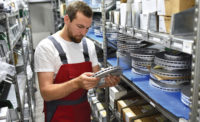Evaluating Adhesive Options in Packaging Applications
Testing which hot-melt adhesive to use for a particular packaging application can be a cost-effective solution.

Fig. 1. Single lap shear adhesive sample.

Fig. 2. Adhesive samples are tested in an environmental chamber.

Fig. 3. Adhesive tensile testing at the Smithers Pira lab.



“Packaging is the largest application within the adhesive sector and continues to support the growing trend of consumerism, pre-packed food, and other articles purchased in a packaged format,” says Ciaran Little, director of Operations, Americas, at Smithers Apex. These changes in consumer behavior are driving manufacturers to evaluate packaging and adhesive effectiveness and costs.
Hot-Melt Adhesive on Corrugated Substrates
Thermoplastic hot-melt adhesives are commonly used for corrugated packaging closures because of their excellent adhesion, quick set and relatively low cost. This makes them ideal for the automated, high-production, high-speed lines used for packaging applications.
But determining which hot-melt adhesive to use for a particular application can be challenging. When faced with choosing a new hot-melt for a corrugated fiberboard box application, a component manufacturer turned to Smithers Pira. The shipping manager wanted to compare two adhesive options while weighing cost against performance, not wanting to sacrifice quality and run the risk of performance degradation as a result of making a purely budget-driven decision.
Adhesive Testing
No standardized preparation or testing methods can currently determine the performance of hot-melt adhesives on a particular corrugated substrate prior to pilot or productions runs. After researching the issue and working with the manufacturer’s logistics and sourcing team, we were able to develop a custom test method that used aspects of the TAPPI T813 standard to evaluate the performance of the hot-melt adhesives.
Single lap shear samples were fabricated in the lab using two different hot-melt adhesive types, Type A and Type B, on a C-flute corrugated substrate. The two hot-melt adhesives were then processed at two different temperatures (375°F and 500°F) before application onto the cardboard samples. After adhesion, the samples were conditioned in a temperature- and humidity-controlled chamber at three different temperatures.
Finally, after conditioning, the samples were subjected to a tensile tester to understand when the adhesive bond would fail with the substrate. The testing protocol found that the less-expensive hot-melt material (Type B) actually performed better than the original hot melt in every tested condition. In addition to exhibiting better performance characteristics, Type B’s cost was 58% lower than Type A, providing a large cost savings opportunity.
Results
The component manufacturer worked with Smithers Pira to test multiple scenarios and find a fact-based, cost-saving decision. The entire process, from project initiation to a final report, took less than three weeks, and the savings and knowledge generated by using learnings from the exercise far outweighed the cost of testing. ASI
For more information, visit www.smitherspira.com.
References
1. “The Future of Adhesives for Packaging to 2021,” Smithers Apex, February 2017.
Looking for a reprint of this article?
From high-res PDFs to custom plaques, order your copy today!











